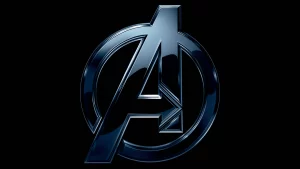
Marvel Studios / The Walt Disney Company
THE AVENGERS
Starring Robert Downey Jr (Tony Stark / Iron Man), Chris Evans (Steve Rogers / Captain America), Chris Hemsworth (Thor), Mark Ruffalo (Bruce Banner / The Hulk), Scarlett Johansson (Natasha Romanoff / The Black Widow), Jeremy Renner (Clint Barton / Hawkeye), Samuel L. Jackson (Nick Fury), Cobie Smulders (Maria Hill), Clark Gregg (Agent Phil Coulson), Stellan Skarsgard (Erik Selvig), Gwyneth Paltrow (Pepper Potts), Tom Hiddleston (Loki) and Paul Bettany (as the voice of JARVIS) with a special appearance by Stan Lee and a mid-credits scene featuring Damion Poitier as Thanos
Directed by Joss Whedon
Produced by Kevin Feige
Written by Joss Whedon with Zak Penn
Music By Alan Silvestri
Distributed by Walt Disney Pictures
Run Time: 2 hours and 23 minutes
World Premier: April 11, 2012, the El Capitan Theater in Hollywood, California
Opening Weekend Box Office: $207 million (North America)
Worldwide Box Office: $1.5 billion
Rotten Tomatoes Score: 91%
The Avengers First Comic Book Appearance: The Avengers # 1 (September 1963)
The Avengers created by Stan Lee and Jack Kirby
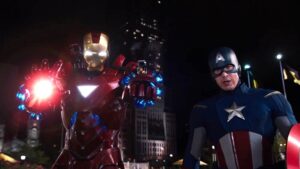
Marvel Studios / The Walt Disney Company
Memorable The Avengers Quotes:
“If we pull this off, it might be kind of a big deal.” – Kevin Feige’s internal feelings as the plan for Marvel Studios’ Road to The Avengers began to come together.
“I wanted people to understand that this was a unique thing that we were doing. These are individual movies with their own franchises, and they are under this umbrella of a shared continuity, which hadn’t been done before.” – Kevin Feige discussing his vision for what became known as the Marvel Cinematic Universe.
“If Thor and Cap had failed, we would’ve had a big problem.”– Kevin Feige reflecting on the immense risk of shooting The Avengers before the release of Thor or Captain America: The First Avenger.
“For years, people were saying ‘You know you guys are crazy, right?’ We were told that every step of the way. ‘Oh, you’re really going to go start your own Studio? That will never work. Oh, you’re going with a B-list character like Iron Man? Good luck with that. Thor? What’s that?’ Avengers just felt like an extension of that … times five! ‘Oh, you’re going to put them all together? The Viking is going to be next to The Hulk? That’s never going to work!’” – Stephen Broussard recalling the various critical reactions to Marvel Studios’ ambition on their Road to The Avengers.
“Because I grew up with the Marvel Universe – with Iron Man, Thor, and Captain America hanging out all the time – I didn’t have to translate it to myself. I think that made it easier. But we were translating it to everybody else. That was a tightrope walk.” – Joss Whedon discussing the challenges of assembling The Avengers on-film.
“I think it was The Avengers. The success of Iron Man was amazing. That gave us the confidence to do another Iron Man film, a Captain America film, and to introduce Thor. The success of The Avengers taught us that the audience really gets what we’re doing, and really enjoys the cross-pollination of all of these different film series. And the audience told us unequivocally they were with us. That allowed us to plot out everything that we’ve done since then. “– Kevin Feige in response to a question asking what moment he realized that what he was setting up was going to be a success.
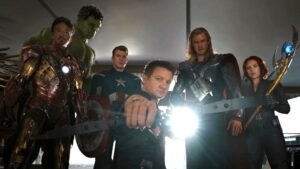
Marvel Studios / The Walt Disney Company
Fun The Avengers Facts:
The Avengers were first introduced as a superhero team in The Avengers # 1 in September of 1963. The team was created for Marvel Comics by Stan Lee and Jack Kirby. The team brought together several Marvel Heroes to join forces against a threat that they could not overcome individually. The inaugural roster of The Avengers was comprised of Tony Stark / Iron Man, Thor, Bruce Banner / The Hulk, Hank Pym / Ant-Man, and Janet Van Dyne / The Wasp. The group came together to fight Thor’s adopted brother Loki, the Asgardian God of Mischief. The Hulk was quickly moved off the team and soon replaced with Steve Rogers / Captain America, who was reintroduced to comic book readers as an Avenger and a Man Out of Time after starring in his own Timely Comics title for several years during the 1940’s.
Marvel Studios’ Road to The Avengers began on September 6, 2005, when Marvel Enterprises changed its corporate name to Marvel Entertainment, reflecting the company’s new initiative to self-finance and produce its own motion pictures through Marvel Studios. Marvel Studios President and COO David Maisel arranged a lucrative $525-million deal with Merrill Lynch to finance the independent movie-making venture, with Marvel putting up the rights to several of its characters as collateral. The new initiative was backed by a lucrative distribution deal with Paramount Pictures that saw Paramount agree to distribute six Marvel Studios films. Following the deal, the Marvel Studios offices would move from its shared office space with the Star Spectra company in Los Angeles to a new Beverly Hills office that was positioned above a Mercedes-Benz dealership.
The Marvel Studios team had many ambitious goals as they began to develop their first films. Movies based on Iron Man, The Incredible Hulk, and Ant-Man were in various stages of development, but all was not well within the Studio. Avi Arad, who’d worked for Marvel Studios since its inception in 1996, producing Marvel movies with New Line Cinema, 20th Century Fox, Sony Pictures, Universal Pictures, and Lions Gate, took issue with the creative direction that the projects were being taken in. Marvel Entertainment CEO Ike Perlmutter sided with David Maisel (who’d brokered the distribution deal with Paramount in addition to coming to terms with Universal on a deal that would see them distribute a Hulk film that would be produced by Marvel Studios), over his longtime business partner Arad, and Avi announced his intended resignation in May of 2006. Avi retained his executive-producer credits on both Iron Man and The Incredible Hulk but was no longer a part of Marvel Studios’ inner circle by the time these films were released. Kevin Feige was in fact promoted to President of Physical Production on the same day that Iron Man commenced filming.
The idea of an Avengers film was first mentioned publicly by Kevin Feige during Marvel Studios’ inaugural independent panel at San Diego Comic Con on July 22, 2006. There, Feige stated that he hoped to see The Avengers assemble on-screen someday and even hinted that the first slate of Marvel Studios films revolving around traditional core members of the team was no coincidence. This same weekend, the Los Angeles Times wrote a story pertaining to Marvel Studios’ venture, mocking the Studios’ ambition with the headline “Marvel Rolls Out the B-Team.”
Filming on Iron Man began on March 12, 2007, and lasted until June 25, 2007. Two weeks after that, filming on The Incredible Hulk began. Filming on Marvel Studios’ second independently produced film would last until November. In the meantime, Marvel Studios returned to San Diego Comic Con where on July 28, 2007, both Iron Man and The Incredible Hulk were heavily promoted and the first footage from Iron Man was screened for the enthusiastic crowd inside SDCC Hall H. This same year, concept artist Ryan Meinerding was tasked with coming up with designs that would show what a potential Captain America movie might look like.

Marvel Entertainment / The Walt Disney Company
With a clear vision and wild ambition, Kevin Feige’s casual mention of an Avengers film grew to be quite serious and the first real step towards this goal manifested itself in the form of a post-credits scene for 2008’s Iron Man. While The Avengers had existed as a Marvel Comics team since 1963, the team had been significantly re-imagined (along with several other Marvel characters) in Marvel’s new Ultimate Universe, which launched in the year 2000 with the Ultimate Spider-Man title. The Ultimate Universe (designated Earth-1610 in the comics) was a way for Marvel to update their characters to a modern setting and this happened with The Avengers (or “The Ultimates” as it were), in 2002 with the release of The Ultimates # 1 written by Mark Millar and illustrated by Bryan Hitch. The inaugural lineup of The Avengers in the Ultimate Universe was comprised of Iron Man (Tony Stark), Giant-Man (Hank Pym), The Wasp (Janet Van Dyne), Captain America (Steve Rogers), and Thor (The God of Thunder), and the team was overseen by Nick Fury and S.H.I.E.L.D. The Ultimates first came together to battle a rampaging Hulk. One of the characters that was most re-imagined in the Ultimate Universe was Nick Fury. Originally a Caucasian, eye-patch wearing, cigar-chomping World War II Colonel when he was first introduced by Stan Lee and Jack Kirby in 1963, Fury was re-imagined in 2001 by Brian Michael Bendis and Mike Allred as an African American that was drawn in the likeness of actor Samuel L. Jackson. In developing the concept for an Avengers film, Marvel Studios looked to both the Lee / Kirby comics and the Ultimate Universe for inspiration, but the Ultimate incarnation of Nick Fury won-out over his 616-Universe (the main continuity in Marvel Comics) counterpart and to portray the role, Marvel Studios cast none other than Samuel L. Jackson! It was decided that Jackson would be introduced during the post-credits scene of Iron Man as the Director of S.H.I.E.L.D. (which had a small presence in Iron Man). During his brief – but immensely important appearance – Jackson’s Fury would confront Robert Downey Jr’s Tony Stark / Iron Man and propose the idea of “The Avenger Initiative”, informing Stark that he’d just become a part of “a bigger Universe.” The Shared Universe that Jackson’s Fury referenced was expanded upon in The Incredible Hulk, which featured Robert Downey Jr’s Tony Stark confronting William Hurt’s General Ross to inform Ross that a team was being put together by S.H.I.E.L.D. The appearance of Downey’s Stark just before the credits of The Incredible Hulk rolled established that Iron Man and The Incredible Hulk take place in the same world. The Marvel Cinematic Universe was born!
Iron Man was a critical and financial success for Marvel Studios, while The Incredible Hulk was a moderate one. Together, Marvel Studios’ first two films generated $850 million worldwide. Following the immensely successful opening weekend of Iron Man, Marvel Studios announced on May 6, 2008, the release dates for four new films: Iron Man 2 on April 30, 2010, Thor on June 4, 2010, The First Avenger: Captain America on May 6, 2011, and The Avengers in the Summer of 2011.
Following the release of Iron Man and with The Incredible Hulk yet-to-be-released, a Marvel Studios team comprised of Kevin Feige, Craig Kyle, Jeremy Latcham, and Stephen Broussard ventured to Palm Springs for what was labeled a “Creative Retreat” to brainstorm and discuss the future of Marvel’s Shared Universe. Select production duties were assigned to Jeremy Latcham (Iron Man 2), Craig Kyle (Thor), and Stephen Broussard (Captain America: The First Avenger) with the goal being to find a way to make these individual films work as their own stories while building to what would be an unprecedented character team-up in The Avengers.
It was during 2008 that the term Marvel Cinematic Universe was first coined. The term began being used in an effort on the part of Marvel Studios to distinguish the movie world from the comics world, with the movie world being clearly established as its own separate continuity in the same way that the 616-Universe and the 1610-Universe were established as being two different continuities in the comics. The MCU eventually received the label of Earth-199999 in the comic book pages, but in the movies, the main MCU continuity that started with Iron Man would ultimately be labeled the “616-Universe” / “Earth-616” and would also come to be known as the “Sacred Timeline.”
Soon after the phrase Marvel Cinematic Universe was coined, Marvel Entertainment CEO Ike Perlmutter oversaw the formation of the “Marvel Creative Committee.” The purpose of this group was to oversee Marvel Studios and ensure that the Marvel Studios team were kept in-check as it pertained to the wishes of Ike Perlmutter and his vision for how the MCU should be shaped. The primary members of the Marvel Creative Committee included Marvel Comics Publisher Dan Buckley, Marvel Comics writer Brian Michael Bendis, Marvel Entertainment CCO Joe Quesada, and Marvel Entertainment President Alan Fine, with Fine being appointed Chairman of the Creative Committee, reporting back directly to Perlmutter. Kevin Feige would clash with this Committee several times over the course of the three years that followed the release of The Avengers, and tensions would eventually escalate to such a volatile point that Feige actually considered resigning from Marvel Studios, prompting Disney CEO Bob Iger to move Marvel Studios out from underneath Marvel Entertainment and place it directly under the Walt Disney Pictures umbrella with Feige no longer dealing with Creative Committee, and no longer answering to Ike Perlmutter, but to Alan Horn instead.
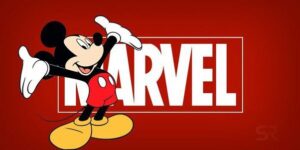
Marvel Entertainment / The Walt Disney Company
With Iron Man and The Incredible Hulk behind them and Iron Man 2, Thor, and Captain America: The First Avenger in various stages of development, the Marvel Studios team were surprised by the August 31, 2009, announcement that The Walt Disney Company and Marvel Entertainment had agreed to terms that would see Disney purchase Marvel Entertainment – and Marvel Studios with it – for $4 billion. The deal would be finalized on December 31, 2009.
In the meantime, Kevin Feige and members of the Marvel Studios team ventured out for another creative retreat to Palm Springs with the goal of figuring out how best to tie all of the films that would lead to The Avengers together aside from the obvious character interactions. It was during this retreat that it was decided that the Cosmic Cube known as the Tesseract would be used to accomplish that goal. It was decided that the Tesseract should come to Earth from Asgard and end up in a box that the Nazis are searching for during World War II and would from there be an object that drives the plot of The Avengers. The Tesseract would end up being introduced in Iron Man 2, seen by Tony Stark as a sketch in a notebook that belonged to his father Howard Stark. It would next appear in all its glowing glory in the post-credits scene for Thor, after which it was shown as fueling the advanced series of weapons wielded by Hydra in Captain America: The First Avenger. The end of that film then showed a young Howard Stark finding the Cube while searching for the crashed remains of The Valkyrie and Captain America. That set the stage for Loki to steal the Cube from S.H.I.E.L.D. in The Avengers, which would lead to the assembling of Earth’s Mightiest Heroes.
From there, Marvel Studios began a serious campaign to find a director for The Avengers. The agent of Joss Whedon contacted Marvel Studios and suggested Whedon for the job. Whedon was a lifelong comic book fan who’d worked previously for Marvel as a comic book writer (check out his stellar Astonishing X-Men run). Whedon was best known for his Buffy the Vampire Slayer, Angel, and Serenity television series’ (Buffy and Serenity were also movies), all of which had been adapted to comics that were published by Dark Horse.
In the Spring of 2010, Iron Man 2 was released worldwide. Though the film was not as critically praised as 2008’s Iron Man, it earned more money, pulling in $623 million worldwide and making Iron Man a billion-dollar franchise.

2010 San Diego Comic Con
On Thursday, July 22, 2010, at San Diego Comic Con, Joss Whedon revealed that he would be directing The Avengers for Marvel Studios. Two days later, on Saturday, July 24, 2010, in Hall H, Marvel Studios formally introduced Whedon to thousands of fans as the director of The Avengers and Whedon joined the cast of the movie (Robert Downey Jr, Samuel L. Jackson, Scarlett Johansson, Chris Hemsworth, Jeremy Renner, Chris Evans, and newcomer Mark Ruffalo alongside Clark Gregg and Kevin Feige) on-stage for the first-ever assembling of the team. Whedon would have the challenging task of making his film before either Thor or Captain America: The First Avenger hit theaters. He would go on to oversee the introduction of Jeremy Renner’s Clint Barton / Hawkeye in Thor and shoot what would be that film’s post-credits scene while also revising select portions of the Captain America script to tie that film in with the world that he was creating in The Avengers.
Before Joss Whedon was hired to direct The Avengers, Zak Penn (who wrote The Incredible Hulk) had written a script that Whedon was allowed to come in and change however he saw fit. Whedon toyed with ideas such as the introduction of The Wasp (who Whedon hoped to cast actress Zooey Deschanel to portray), while also toying with the idea of Ezekiel Stane (the son of Iron Man‘s Obadiah Stane) being included in the film as a villain. Marvel Studios would end up rejecting both of these ideas however, as the introduction of new characters was not something that the Studio wanted to concern themselves with. The Marvel Studios team instead wanted to focus on Loki as the primary antagonist since audiences that watched Thor would already be familiar with his backstory. Joss Whedon would later admit that this was the right call, noting that the idea of The Wasp only came about due to the uncertainty at the time of whether or not Scarlett Johansson’s Natasha Romanoff / The Black Widow would be in the film.
Joss Whedon did end up introducing another important female character in The Avengers however, in Deputy Director of S.H.I.E.L.D. Maria Hill. Actress Cobie Smulders was cast to portray Hill, who would be Nick Fury’s right-hand woman in the film. The World Security Council would furthermore be introduced in The Avengers. This was a governing body that oversaw S.H.I.E.L.D., and that Nick Fury had to answer to. We would learn in The Avengers that the World Security Council shut-down Nick Fury’s Avengers Initiative, as they wanted Fury to focus all of his attention on the Phase II Protocol, which we would learn in The Avengers was a directive to use the Tesseract to power weapons akin to how Hydra did during World War II.

Marvel Studios / The Walt Disney Company
As Marvel Studios developed The Avengers, one of the primary objectives was improving upon The Hulk from 2008’s The Incredible Hulk. The Hulk was a character that everyone at Marvel wanted to “get right.” It was an incredible undertaking for everyone involved to achieve the final look of The Hulk, which would this time around be based on the physical characteristics of actor Mark Ruffalo. Marvel Studios sought to bring more of the actor into the Hulk persona than ever before. Motion capture was utilized as were textures from Mark Ruffalo’s actual likeness to bring the CGI Hulk to life.
Other CGI character creations were Loki’s extraterrestrial army which included the cybernetically-enhanced Chitauri and the massive cybernetically-enhanced Leviathan beasts which the Chitauri used as makeshift warships. As the mythology of the Cosmic Warlord Thanos would continue to evolve in the MCU beyond this film, viewers would learn that it was the Mad Titan specifically that had cybernetically enhanced these alien species, utilizing them to do his bidding throughout the Universe. More on Thanos in a bit.
Along with The Hulk, the Chitauri, and the Leviathan, CGI was furthermore used to bring the S.H.I.E.L.D. Helicarrier to life. The Helicarrier is S.H.I.E.L.D.’s mobile command center and launching platform. It is fully submersible and seaworthy and is a maneuverable aircraft as well! The Helicarrier boasts four large turbine rotor engines that enable it to achieve sustained flight at altitudes up to 30,000 feet. It also boasts a holographic stealth technology that obscures its hull when viewed below, allowing the craft to be hidden from most of the population. The Helicarrier carries a large supply of S.H.I.E.L.D. Quinjets and helicopters in addition to dozens of S.H.I.E.L.D. crew members and agents. VFX artists built a detailed model of the Helicarrier and constructed the animated environment around it – everything from air being pulled into the propeller, to crashing waves, to water dripping down the sides, to smoke and fire during Hawkeye’s invasion.
The Avengers ultimately boasted more than 2,200 visual effects shots that were completed by fourteen different companies.
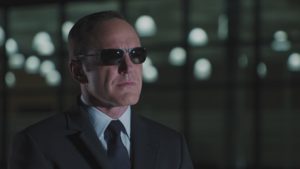
Marvel Studios / The Walt Disney Company
Prior to the start of Principal Photography, Kevin Feige issued a mandate that Clark Gregg’s Agent Phil Coulson be killed-off in The Avengers, according to Joss Whedon, who agreed that killing-off Coulson made sense, as it gave the film stakes without killing-off one of The Avengers while also giving The Avengers something to avenge.
Coming into The Avengers, the five MCU films produced by Marvel Studios that preceded it had grossed a combined $2 billion, 294 million worldwide.
The Avengers commenced filming on April 25, 2011. Chris Evans, the star of Captain America: The First Avenger had to pretty much shoot that film and The Avengers back-to-back, with no way of knowing how the Captain America film would be received. Filming on The Avengers began in Albuquerque, New Mexico. The following month, filming moved to the State of Pennsylvania. Filming took place in the State of Ohio in August, before moving to New York City where filming concluded.
Several scenes in The Avengers were improvised, including Robert Downey Jr’s “Doth mother know you weareth her drapes?”, “Let’s just not come in tomorrow”, and “That man is playing Galaga!” lines, in addition to the Hulk’s roar to awaken Iron Man after his brief journey to the other side of Space.

Marvel Studios / The Walt Disney Company
The Avengers marked Stan Lee’s sixth Marvel Studios cameo appearance within the MCU, making him the only actor to appear in all six of Marvel Studios’ Phase One MCU films. The person closest to Lee at the time in terms of number of appearances was Samuel L. Jackson with five (Iron Man, Iron Man 2, Thor, Captain America: The First Avenger, and The Avengers). If including the Marvel One-Shot’s however, The Avengers marked Clark Gregg’s sixth MCU appearance as well (Iron Man, Iron Man 2, Thor, The Consultant, A Funny Thing Happened on the way to Thor’s Hammer, and The Avengers), which would tie him with Stan Lee at that time.
Alan Silvestri composed the score for The Avengers, and it was Silvestri who came up with the now iconic theme for The Avengers. Silvestri had previously worked with Marvel Studios on Captain America: The First Avenger.
Soundgarden’s Live to Rise was written specifically for The Avengers, marking the first time a rock band had ever written a song specifically for a Marvel Studios film.
In August-2011, at the D23 Expo in Anaheim, California, Marvel Studios unveiled the first footage from The Avengers to the public. In October, Marvel Studios unveiled more footage at the 2011 New York Comic Con. Later that same month, the first full-length trailer for The Avengers was released. The trailer was released exclusively on iTunes and was reportedly downloaded 10-million times during its first 24-hours of release. A 30-second trailer aired during the NFL’s Super Bowl XLVI on February 5, 2012, and later that month an official second Avengers trailer was released on iTunes. The second trailer achieved 13.7 million downloads in its first 24-hours of release.
Promotional partners for Marvel Studios on The Avengers included Acura, Dr. Pepper, Farmers Insurance, Hershey, Oracle, Red Baron Pizza, Visa, Symantec, Burger King, Dunkin’ Doughnuts, and Wyndham Hotels & Resorts.
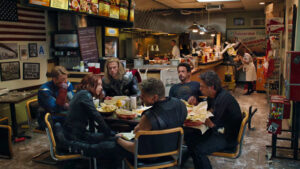
Marvel Studios / The Walt Disney Company
The Avengers marked the first time that a Marvel Studios film boasted TWO credits scenes. The mid-credits scene introduced the Mad Titan Thanos (portrayed by actor Damion Poitier) as the entity that Loki had been working for. The post-credits scene showed The Avengers eating Shawarma. The second scene was actually filmed on April 12, 2012, at the World Premiere for The Avengers.
The Avengers was the first Marvel Studios film to be distributed by Walt Disney Pictures. Paramount Pictures had distributed Iron Man, Iron Man 2, Thor, and Captain America: The First Avenger. Universal Pictures distributed The Incredible Hulk.
The Avengers set numerous box office records in North America and worldwide. The Avengers set the record for Highest Opening Weekend for any film in North America ($207 million), Highest Opening Week for any film in North America ($270 million), Highest Second Weekend for any film in North America ($103 million), Highest May Opening of all-time in North America ($270 million), and Highest-Grossing Superhero Film in North America ($623 million). Worldwide, The Avengers became the third Highest-Grossing film of all-time ($1.5 billion), and the Highest-Grossing film of 2012 ($1.5 billion). The success of The Avengers elevated the Marvel Cinematic Universe franchise to $3-billion and 813 million worldwide.
On July 22, 2012, at the Teen Choice Awards, The Avengers won the Award for Choice Summer Movie and Choice Summer Movie Star: Chris Hemsworth. On October 10, 2012, at the Hollywood Film Festival, The Avengers won the Visual Effects Award. On January 9, 2013, at the People’s Choice Awards, Robert Downey Jr won the Awards for Favorite Movie Actor and Favorite Movie Superhero for his role as Tony Stark / Iron Man in The Avengers, while Chris Hemsworth won the Award for Favorite Action Movie Star. On February 5, 2013, at the Visual Effects Society Awards, The Avengers won the Awards for Outstanding Visual Effects in a Visual Effects-Driven Feature Motion Picture and Outstanding Models in a Feature Motion Picture (for the Helicarrier). On April 14, 2013, at the MTV Movie Awards, The Avengers won the Award for Best Fight (the Battle of New York), while Tom Hiddleston won the Award for Best Villain for his role as Loki in The Avengers. On May 11, 2013, at the Taurus Stunt Awards, The Avengers won the Awards for Best Fight, Best High Work, Best Overall Stunt by a Stunt Woman, and Hardest Hit. On June 26, 2013, at the Saturn Awards, The Avengers won the Awards for Best Science Fiction Film and Best Special Effects, while Joss Whedon won the Award for Best Director, and Clark Gregg won the Award for Best Supporting Actor for his role as Agent Phil Coulson in The Avengers. On September 1, 2013, at the Hugo Awards, The Avengers won the Award for Best Dramatic Presentation – Long Form.
The Avengers was released on DVD, Blu-ray, and Blu-ray 3D on September 25, 2012, in the United States. The Blu-ray release included the Marvel One-Shot: Item 47 short film, Today, The Avengers is available for streaming on Disney+.
In 2023, Marvel Studios endorsed the publishing of a book titled Marvel Studios – The Marvel Cinematic Universe: An Official Timeline which was created to end ongoing debates pertaining to when exactly select events within the MCU transpired. These debates stemmed from a number of continuity errors within the MCU over the years. The book officially established that Tony Stark became Iron Man in 2008, that most of the events that occurred in The Incredible Hulk, Iron Man 2, and Thor happened concurrently in 2010, and that Steve Rogers was pulled out of the ice by S.H.I.E.L.D. in 2011. The Avengers has been confirmed to take place in the Spring of 2012.
As the MCU evolved, both the Tesseract and the gem within Loki’s Cosmic Sceptor would both be revealed to be Infinity Stones; two of six singularities that were crystalized upon the Big Bang and sent spiraling out across the virgin Universe. Each Stone represented a different aspect of the Universe and were capable of unimaginable destruction should they ever be wielded together (Space, Mind, Power, Time, Reality, Soul). The Tesseract contained the Space Stone, and the Scepter contained the Mind Stone. It would also be later revealed that the Cosmic Warlord Thanos was obsessed with collecting these Stones and wielding their collective power simultaneously. Already in possession of the Mind Stone, Thanos lent the Infinity Stone to Loki, hoping that Loki would retrieve for him the Tesseract in exchange for the Throne of Earth. Loki of course failed, and Thanos came out of the events seen in The Avengers with no Infinity Stones to call his own and a mighty grudge against Earth’s Mightiest Heroes.
In the 2019 Marvel Studios film Captain Marvel, the inspiration for Nick Fury’s “Avenger Initiative” is revealed to be a former United States Airforce pilot named Carol Danvers, who was exposed to the power of the Tesseract and imbued with superhuman powers, becoming “Captain Marvel.” Fury and Danvers became fast friends after she returned to Earth from the planet Hala after a six-year absence and together, they stood against the attempted eradication of the benevolent shapeshifting alien race known as The Skrulls. Obviously, S.H.I.E.L.D.’s encounter with Thor (as seen in Thor) was not Nick Fury’s first interactions with an extraterrestrial, even though he states otherwise in The Avengers (always remember, his secrets have secrets). Carol’s Airforce callsign was “The Avenger”, hence the name of Fury’s team and Initiative. At the time in which the primary events of The Avengers take place in 2012, Danvers has been off world for seventeen years.
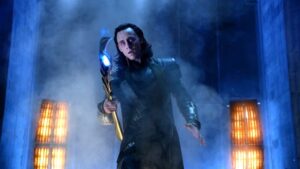
Marvel Studios / The Walt Disney Company
My The Avengers Review
“There was an idea … to bring together a group of remarkable people, to see if they could become something more. See if they could work together when we needed them to, to fight the battles we never could.”
The above quote (uttered by Nick Fury in The Avengers) perfectly encapsulates the plot of this film. The group is The Avengers. The threat is Loki. Let’s Go! Loki, armed with his Cosmic Scepter, arrives on Earth and decimates S.H.I.E.L.D. personnel, not only killing many agents, but using the Scepter to overtake the mind of Clint Barton, who helps Loki make an escape with the Tesseract in his custody. Nick Fury gives chase, but he is no match for the God of Mischief, prompting him to assemble his team. Natasha Romanoff recruits Bruce Banner. Phil Coulson recruits Tony Stark. Nick Fury recruits Steve Rogers. Each character is introduced seamlessly with a mix of witty banter and a sense of urgency. Loki is soon located in Germany and Captain America and The Black Widow are sent in to confront him. Iron Man interrupts the party, and the tension between Tony and his dad’s hero Steve is there from the start. As Loki is transported back to the S.H.I.E.L.D. Helicarrier, Thor arrives, having been sent by Odin through the conjuring of dark energy. Thor casually whisks Loki away, prompting Iron Man and then Cap to give chase. The three heroes partake in a battle that levels a small forest before Cap calls for a truce and they return to the Helicarrier with Loki in tow. There, Loki sets into motion a master plan in which he intended to get captured so that he could use his skills to unleash The Hulk upon the Helicarrier after which Hawkeye would arrive and wage war against his companions. The plan almost worked and surely would have had Iron Man and Captain America not teamed up to keep the Helicarrier in the air and had Black Widow not broken Loki’s hold over Barton. During the carnage, Loki also manages to kill Phil Coulson. Loki returns to New York and with something to know avenge, The Avengers unite to take down Loki and his extraterrestrial army. Believing the hope for victory to be lost, The World Security Council orders Fury to bomb New York and when he refuses, they override him. Iron Man manages to commandeer the missile though, flying it into the open portal above New York through which Loki’s army were arriving. The bomb detonates on the other side of Space right in front of Thanos’ warship (Sanctuary), and the Battle of New York is won by The Avengers! Loki is returned to Asgard in the custody of Thor, along with the Tesseract while S.H.I.E.L.D. takes custody of the Scepter. The rest of The Avengers go their separate ways until the time when their services would be needed again.
For me, The Avengers was the greatest motion picture I’d ever seen when it was released. I have so many fond memories of venturing out to the theater with my wife on Friday, May 4, 2012, and seeing this film for the first time. It’s difficult to accurately describe how much I enjoyed this movie and how much I was anticipating seeing it! There had never been a film quite like The Avengers before, and Kevin Feige, after fending off years of doubts from critics and naysayers came out of this film looking like a genius and a rock star, with Marvel Studios suddenly emerging as the hottest commodity in Hollywood with multiple Film Studios scrambling to emulate Marvel Studios’ success.
The Avengers lived up to every bit of the hype that preceded its release, emerging as a comic book movie masterpiece that was celebrated as such by millions of Marvel fans. I know that Joss Whedon isn’t very popular these days, but the outstanding work he did with this script and the juggling of so many characters, being sure to give everyone a memorable moment and staying true to the spirit of the characters that had already been established in previous films, cannot be denied. Three characters shined for me above all others in The Avengers however: Loki, The Hulk, and Black Widow.
Tom Hiddleston was every bit as good as Loki in The Avengers as he was in Thor. The God of Mischief’s story carried over from his Fall from Asgard into the custody of the Mad Titan Thanos, who armed Loki with the Cosmic Scepter and his Chitauri and Leviathan armies, then sent him to Earth to commandeer the Tesseract and return it (and the Scepter) to him. Loki would in-exchange be granted rule over Earth, claiming the throne that was denied him in Thor. In typical Loki fashion, Loki is the hero of his own story within his own mind. He sees himself as humanity’s potential savior; the god that can bring peace to Midgard through practical enslavement. Loki views himself as a higher life-form than the lowly humans who inhabit Earth, pointing out the chaos that consumes their lives and vowing to end it through enforced control. Ruling Earth really serves two purposes for the God of Mischief. Not only is it a way to claim a throne, which he, as the son of Laufey and the adopted son of Odin, believes is his birthright, it is also a way to stick-it to Odin and Thor. Odin had served as a protector of humanity in the distant past, while Thor had grown quite fond of human beings after being cast out of Asgard to Earth. Select humans still revered Odin and Thor as gods and worshiped them accordingly. Loki conquering Earth would in his mind, establish his superiority over his adopted brother and father. Though Loki’s time with Thanos isn’t really shown on-screen, it can be deduced while watching the film that he has changed dramatically from who he was in Thor. Loki in fact brazenly brags about his personal growth and the things that he has learned from Thanos, who showed him worlds far beyond the Nine Realms that Odin never permitted Loki or anyone else from that generation of Asgardians to know.
It was so cool to see Tom Hiddleston’s Loki share the screen with Samuel L. Jackson’s Nick Fury at the beginning of the film, and Loki’s dialogue was the stuff of greatness during their exchange. It was then a dream come true for me to see Loki battle Captain America in live-action, and I really loved the scene between Loki and Thor on the cliff. I also thought Loki’s plan to counteract the assembling of The Avengers was good, as he tried to tear the team apart before they could ever come together. I know a lot of people felt that Jeremy Renner’s Hawkeye got short-changed in this film, and I understand that opinion, but Loki’s plan was reliant upon top-secret S.H.I.E.L.D. information, which he obtained from Hawkeye; a member of Nick Fury’s inner circle, and himself a candidate for the Avengers Initiative. So, it made a lot of sense from a narrative perspective for Loki to brainwash Hawkeye; the Avenger that had been the least-established coming into this film.
From there, the Battle of New York featured a lot of great Loki moments, from his verbal exchange with Tony Stark, to his rematch against Thor, to his catching Hawkeye’s arrow (even though it exploded). As a Loki fan, I refuse to condone The Hulk’s brutal manhandling of the god of Mischief on the top floor of Stark Tower, but I will acknowledge that it is one of the more iconic moments to come out of this movie. I know that Hulk fans loved it, and that brings me to the Green Goliath.
The Avengers truly got The Hulk right, not just the look, but the attitude! The best thing about The Hulk for me was the smashing! There are several Hulk stories that I love from the comics, but those stories are usually fueled by the art. The Hulk is just this mammoth, awesome, force of nature that wrecks everything in his path and I loved watching The Hulk just destroy the Chitauri and the Leviathan! That one-punch blow to the Leviathan when Bruce Hulks-Out was so very awesome and the fact that we saw The Hulk SMILE after Captain America instructs him to smash was so cool! In The Incredible Hulk, The Hulk looked so SAD at various times, so it was great to see the monster sort of embrace who and what he is and have fun with it. I am not in the minority of enjoying The Hulk in The Avengers, it was a common sentiment amongst fans, and I absolutely concur that he was a highlight of this epic film, and kudos to Mark Ruffalo for everything that he contributed.

Marvel Studios / The Walt Disney Company
Black Widow was great as well! She was executed as just being a kick-ass character in The Avengers. Her opening scene was really good, manipulating and dominating those Russians, and her out-witting of Loki was great. She did the most with the least to work with during the battle of New York in terms of enhancements, and Scarlett Johansson brought a lot of attitude and a lot of physicality to the role. I came out of this film really wanting to see more Natasha Romanoff!
It’s difficult for me to narrow down one favorite scene from The Avengers, but I think I’d have to go with the Battle of New York as a whole. This was a 45-minute spectacle! That epic circular shot with Alan Silvestri’s theme playing stands out of course, but there was SO much to unpack here and enjoy! It was something that, at the time, I never thought that I would ever see! Iron Man, Captain America, Thor, The Hulk, The Black Widow, and Hawkeye working with Nick Fury on behalf of S.H.I.E.L.D. against Loki and a bunch of extraterrestrial creatures in a live-action movie! It was as surreal as it was amazing and watching it makes me smile to this day! Iron Man and Captain America working together against the Chitauri with the repulsor blast / shield combo was great, Captain America fighting alongside Thor was so good, Black Widow’s springboard off of Cap’s shield was epic, there was Iron Man’s “Jonah” moment, and of course, Stark’s willing sacrifice to commandeer the nuclear warhead and detonate it on the other side of Space was such a great character moment for him!
I also loved the Battle aboard the Helicarrier too! We got to see Mark Ruffalo’s inaugural Hulk-Out here, we got to see Thor vs The Hulk, Hawkeye vs The Black Widow, an Iron Man / Captain America team-up, and of course, the death of the beloved Agent Coulson at the hands of Loki. It was a magnificent sendoff to the Coulson character, as it was his death that ultimately inspired The Avengers to get on the same page.
The Avengers was funny, exciting, suspenseful, and overall … immensely satisfying! At the time, I don’t think I’d ever had so much fun in a theater. I laughed, I cried, and I cheered, as did everyone else in the theater it seemed. The Avengers wasn’t just a movie, it was an event, and it worked on every level, from adapting the spirit of the comics, to the direction, to the production, to the story, to the effects, to just SEEING all of these characters together on the screen at the same time! It was unlike anything in Hollywood history, and I still feel today like I was just lucky to be alive to see it and experience it! I have no idea how many times I’ve watched this film all these later, but it’s a lot, and this is one of the MCU’s most re-watchable films for me.
The Avengers achieved monumental critical and financial success. It was the culmination of Marvel Studios’ Phase One, but ultimately, just another chapter in what was later labeled The Infinity Saga. It was a true achievement in filmmaking and in fan-service and it will stand for all time as one of Marvel Studios’ finest – and most important – productions.

Marvel Studios / The Walt Disney Company
Highlights of The Avengers:
Tom Hiddleston is Loki
The Hulk is Finally Done Right with Mark Ruffalo as Bruce Banner / The Hulk
Scarlett Johansson kicks ass as Natasha Romanoff / The Black Widow
Tension between Heroes Iron Man and Captain America
Chemistry between Chris Hemsworth and Tom Hiddleston
Chemistry between Robert Downey Jr and Gwyneth Paltrow
Captain America vs Loki
Thor and Loki’s conversation upon the cliff
Thor vs Iron Man in the forest (with Captain America)
Thor vs The Hulk aboard the Helicarrier
The Avengers Assemble during the Battle of New York
The Helicarrier brought to life
The tragic Death of Phil Coulson
Witty Banter Throughout amidst all of the Action and Drama
Mid-Credits Scene with Thanos Reveal
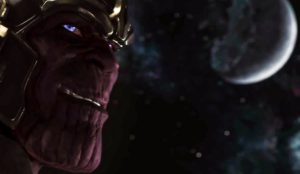
Marvel Studios / The Walt Disney Company
Continue Following Tony Stark’s MCU journey in Iron Man 3 (2013), Avengers: Age of Ultron (2015), Captain America: Civil War (2016), Spider-Man: Homecoming (2017), Avengers: Infinity War (2018), and Avengers: Endgame (2019).
Continue Following Steve Rogers’ MCU journey in Captain America: The Winter Soldier (2014), Avengers: Age of Ultron (2015), Captain America: Civil War (2016), Spider-Man: Homecoming (2017), Avengers: Infinity War (2018), Captain Marvel (2019), and Avengers: Endgame (2019).
Continue Following Thor’s MCU journey in Thor: The Dark World (2013), Avengers: Age of Ultron (2015), Thor: Ragnarok (2017), Avengers: Infinity War (2018), Avengers: Endgame (2019), and Thor: Love and Thunder (2022).
Continue following Natasha Romanoff’s MCU journey in Captain America: The Winter Soldier (2014), Avengers: Age of Ultron (2015), Captain America: Civil War (2016), Avengers: Infinity War (2018), Captain Marvel (2019), Avengers: Endgame (2019), and Black Widow (2021).
Continue following Clint Barton’s MCU journey in Avengers: Age of Ultron (2015), Captain America: Civil War (2016), Avengers: Endgame (2019), Black Widow (2021), and Hawkeye (2021).
Continue following Bruce Banner’s MCU journey in Iron Man 3 (2013), Avengers: Age of Ultron (2015), Thor: Ragnarok (2017), Avengers: Infinity War (2018), Captain Marvel (2019), Avengers: Endgame (2019), Shang-Chi and the Legend of the Ten Rings (2021), and She-Hulk: Attorney at Law (2022).
Continue following Loki’s MCU journey in Thor: The Dark World (2013), Thor: Ragnarok (2017), and Avengers: Infinity War (2018).
Continue following Nick Fury’s MCU journey in Captain America: The Winter Soldier (2014), Avengers: Age of Ultron (2015), Avengers: Infinity War (2018), Captain Marvel (2019), Avengers: Endgame (2019), Spider-Man: Far From Home (2019), Secret Invasion (2023), and The Marvels (2023).
Continue following Maria Hill’s MCU journey in Captain America: The Winter Soldier (2014), Avengers: Age of Ultron (2015), Avengers: Infinity War (2018), Avengers: Endgame (2019), Spider-Man: Far From Home (2019), and Secret Invasion (2023).
Continue following the MCU journey of Jasper Sitwell in Marvel One-Shot: Item 47 (2012), and Captain America: The Winter Soldier (2014).
Continue following the MCU journey of S.H.I.E.L.D. in Marvel One-Shot: Item 47 (2012), Captain America: The Winter Soldier (2014), Ant-Man (2015), Ant-Man and The Wasp (2018), Captain Marvel (2019), and Black Widow (2021).
Continue following Pepper Potts’ MCU journey in Iron Man 3 (2013), Spider-Man: Homecoming (2015), Avengers: Infinity War (2018), and Avengers: Endgame (2019).
Continue following Erik Selvig’s MCU journey in Thor: The Dark World (2013), Avengers: Age of Ultron (2015), and Thor: Love and Thunder (2022).
Continue following Phil Coulson’s MCU journey in Captain Marvel (2019).
Continue following the MCU journey of Thanos in Guardians of the Galaxy (2014), Avengers: Age of Ultron (2015), Avengers: Infinity War (2018), and Avengers: Endgame (2019).

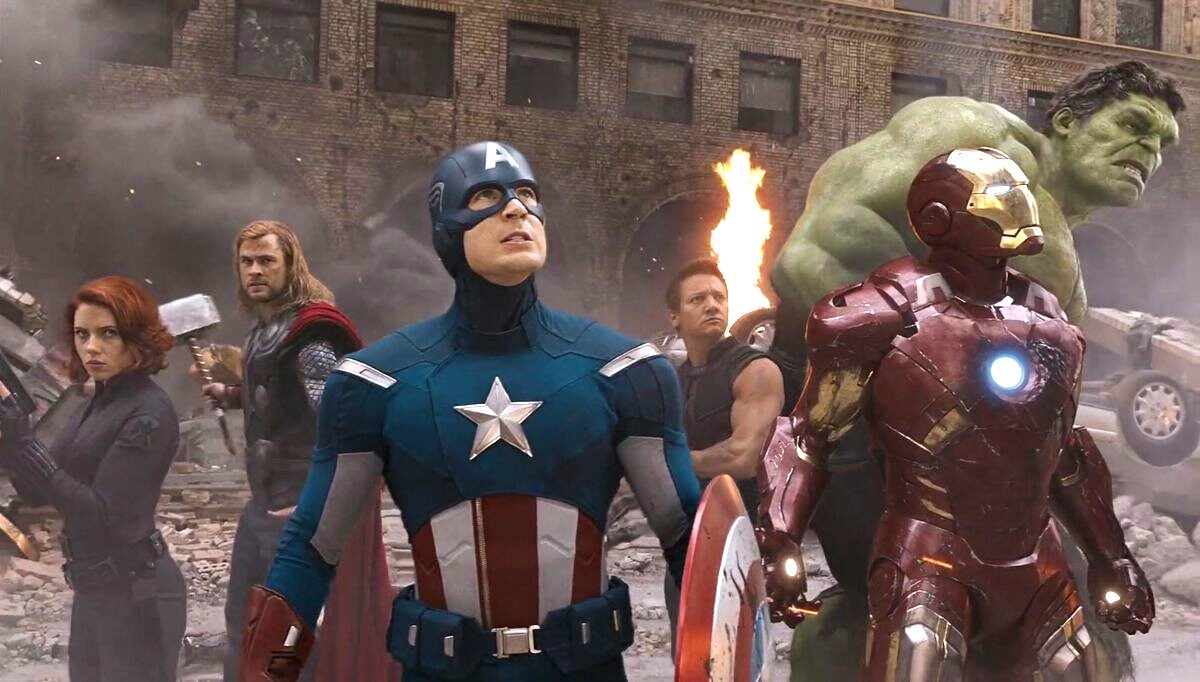
Leave a Reply